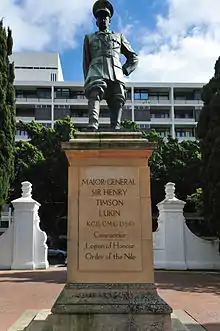Anton van Wouw | |
|---|---|
 Anton van Wouw | |
| Born | 27 December 1862 |
| Died | 30 June 1945 (aged 82) |

Anton van Wouw (27 December 1862 – 30 July 1945) was a Dutch-born South African sculptor regarded as the father of South African sculpture.[1]
Biography
Van Wouw decided to move to the developing city of Pretoria at the age of 28 and waited for ten years to receive his first commission. This was from financier Sammy Marks to create a monumental statue of Paul Kruger, which stands on Church Square.
During his time spent in the wilderness he developed a great admiration for the Boer nation. This also influenced his artistic development a great deal. He identified with the struggles and hopes of these people and this commitment was reflected in his work.

A great deal of his work, although representational, captures the rugged and emotional essence of his subjects. One of his most notable pieces of work is the figure of a woman used in the Women’s Monument near Bloemfontein. He collaborated on this with the architect Frans Soff. He was also responsible for the less successful figure of a woman incorporated into the Voortrekker Monument near Pretoria, a powerful bust of General Christiaan de Wet and the statue of Louis Botha in Durban.
He also portrayed indigenous peoples and among these smaller sculptures some of his finest work can be found. They are much less formal than his larger work and are appealing in their vivid and lifelike facial expressions.
Works
Woman and Children, completed in 1938. This bronze statue honouring the role the Voortrekker women played in the Great Trek was van Wouw's last commission. The sculpture is located at the base of the Voortrekker Monument in Pretoria, stands 4.1 meter tall and weights 2.5 ton. The casting was done by Renzo Vignali in Pretoria. Models for the statue were Cato Roorda or Isabel Snyman as the woman, Betty Wolk as the girl and Joseph Goldstein as the boy
Remembered
- Laerskool Anton van Wouw is a primary school named after van Wouw in the Pretoria suburb of Brooklyn.
- Van Wouw Museum located in his final residence.
Gallery
 Statue of Paul Kruger, 1899, on Church Square, Pretoria
Statue of Paul Kruger, 1899, on Church Square, Pretoria Statue of Jan Hendrik Hofmeyr, 1916, Church Square, Cape Town
Statue of Jan Hendrik Hofmeyr, 1916, Church Square, Cape Town Statue of Martinus Theunis Steyn, 1928, for the University of the Free State, moved to the Museum of the Boer Republics in 2020
Statue of Martinus Theunis Steyn, 1928, for the University of the Free State, moved to the Museum of the Boer Republics in 2020
 Woman and Children, 1939, Voortrekker Monument
Woman and Children, 1939, Voortrekker Monument
See also
References
- ↑ Burger, E. Die Huiselike Omstandighede van Anton van Wouw. University of Pretoria, 1941, p. 21